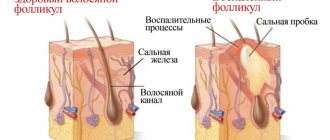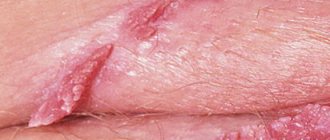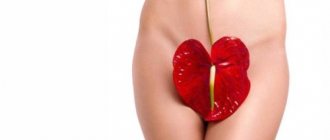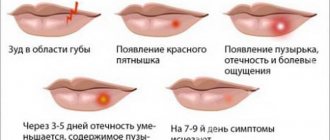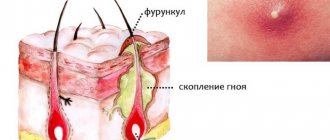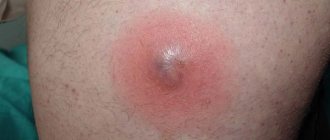What is the danger?
The danger of a boil is that it can cause complications if it is untimely or incorrectly treated, as well as if you squeeze out the abscess yourself or do not follow the rules of antiseptic treatment.
An abscess on the labia, where many blood vessels are located, is fraught with the spread of infection through the bloodstream into neighboring tissues and internal organs.
What complications can a boil in the intimate area lead to:
- furunculosis - the formation of multiple ulcers at different stages of maturation. Foci of inflammation of the hair follicles occur constantly, due to which the body is subjected to severe intoxication;
- phlegmon - a purulent process in the subcutaneous fatty tissues. The disease progresses rapidly due to the absence of a restrictive capsule and spreads through different layers of the skin, muscles and internal organs; we wrote about how it can be cured in this material;
- lymphadenitis - inflammation of the lymph nodes mainly in the groin area;
- phlebitis - an inflammatory process in the walls of venous vessels;
- sepsis - the spread of infection through the bloodstream with further purulent inflammation throughout the body. The disease is serious, difficult to treat and often fatal.
Do you think it is possible to get chickenpox a second time? Find the correct answer to the question in this publication.
Carbuncle - what is it? What are the reasons for its occurrence? How is it different from a boil? How and with what is it treated? Our article will talk about this.
How to treat purulent inflammation
Some women panic and don’t know what to do when a boil forms on the labia. The feeling of discomfort in an intimate place, and even in combination with a purulent formation, causes them a feeling of fear and forces them to urgently consult a doctor. Others, most likely those who have already encountered a similar problem, begin to treat boils on their own according to an already proven scheme.
But the methods used to treat a boil on the labia only turn out to be fast-acting if the woman takes care of strengthening her general and local immunity during the treatment period. As a rule, this factor is not taken into account when self-medicating, which causes prolonged healing of the purulent focus.
Treatment of a boil on the labia can be local, in which external solutions, ointments, gels are prescribed, or systemic, in which antibacterial and anti-inflammatory drugs are prescribed in tablets or injections.
During the treatment of a boil on the labia, the patient is prescribed drugs that strengthen the immune system - Cycloferon, Immunal, Echinacea, aloe injections, B vitamins.
The doctor chooses a treatment regimen for a boil in an intimate place, taking into account the severity of the disease:
- To treat a boil that is at the stage of infiltration, when the boil is just maturing, a 2% solution of salicylic acid or 70% ethyl alcohol is used to cauterize and resolve the subcutaneous neoplasm. Dry heat, magnetic therapy sessions and oral antibiotics help to interrupt the inflammatory process.
- The purulent-necrotic stage is treated using novocaine and antibacterial blockade. The pathological focus is injected with an antibiotic and novocaine, which helps relieve pain and limit the spread of infection under the skin. Ichthyol ointment is applied to the abscess until it breaks through and its core comes out.
- An opened boil is treated with ointment with the antibiotic Levomekol or Levosin. If the wound is too deep, it is drained.
Opening an abscess on the labia is performed on an outpatient basis. The doctor resorts to surgical intervention if the boil does not break through for a long time or has taken on an abscess form. The operation consists of the following steps:
- Antiseptic treatment of infected skin is carried out.
- The doctor opens the abscess using a sharp scalpel.
- The contents of the boil cavity are removed, and the wound is treated with an antiseptic and covered with an antiseptic ointment bandage.
Opening a boil on the labia is done under local anesthesia.
If a boil in an intimate place is just beginning to develop, then it can be cured at home by cauterizing the pathological focus with a 2% solution of salicylic acid or a 70% solution of ethyl alcohol. With strong immunity, the subcutaneous neoplasm resolves within 24 hours. Otherwise, a purulent point will form in the center of the infiltrate.
Ichthyol ointment will help speed up the process of boil ripening at home. It must be kept on the abscess until it opens. The ointment bandage is fixed to the skin with a patch and changed 2 times a day until all the pus comes out. To heal the resulting wound, use ointment with the antibiotic Levomekol and a bactericidal patch.
If a boil appears on the labia, consult a doctor immediately. He will prescribe appropriate treatment and prescribe the necessary medications. Interrupting treatment on your own is not recommended. This will lead to recurrence of the disease.
Medication
To treat boils, external and internal drugs are used, that is, ointments and tablets. Ointments relieve inflammation, have an antiseptic effect, and also help reduce pain and burning. The most suitable ointments for the treatment of furunculosis:
- heparin;
- Vishnevsky;
- ichthyol;
- synthomycin;
- zinc;
- levomekol;
- baneocin.
Antibiotics for internal use are also used in treatment. Medicines are prescribed by a doctor after tests. Tetracycline is most often prescribed.
Do not take these medications without your doctor's advice. The wrong dosage will make you feel worse and will not help cure the disease.
Pulling ointments
Such ointments are used against boils on the genitals at the initial stage; they draw out pus and contribute to the development and formation of an abscess. Thus, the boil matures and opens faster.
Your doctor may prescribe the following ointments:
- Ichthyol ointment - can be used when a boil just appears on the genitals, used in the form of compresses that are applied for 2-3 hours.
- Heparin ointment - has anti-inflammatory, vasodilating and antiseptic effects, cannot be used during pregnancy.
- Syntomycin ointment - in addition to drawing out pus, it has a drying and healing effect; for furunculosis, it is used under a bandage.
How to treat boils on the genitals?
It should be noted once again that only eliminating the cause of boils, that is, infection, will help get rid of them once and for all. During the period of exacerbation of the disease, treatment is divided into local and general. Local remedies include:
- Any disinfecting solutions (antiseptics) - Chlorhexidine, Betadine, Yoddicerin, Fukortsin and others. Their task is to neutralize the infection and prevent its spread to neighboring tissues.
- In order to stimulate the release of pus out, you can use salt lotions. A hypertonic salt solution will draw fluid from the boil and pus along with it.
- Antibacterial ointments are used to reduce pain, swelling and fight infection. They must be water-based in order to penetrate well and act on bacteria directly at the source. These include Levomekol, Oflocain. Vishnevsky ointment is not recommended for use in the first stages. It absorbs pus well and promotes its spread throughout the tissues, which can lead to the development of phlegmon. This ointment can be applied after the boil has ruptured.
- Oral antibiotics are prescribed when the type of pathogen is determined. This can be determined by culturing the contents of the boil and determining the growth of bacteria. Antibacterial therapy can also be carried out after opening the boil, when the acute process goes away. If the boil threatens complications or is accompanied by severe symptoms, then antibiotics are prescribed immediately.
Surgical treatment is indicated for multiple boils, lack of effect from local or antibacterial therapy, in the patient’s serious condition, as well as in the development of complications.
Using a laser
This method is more innovative than the standard surgical removal of a boil in the vagina. It clears up in 20 minutes, and there is no scar left after treatment. To treat chiria on the genitals, you only need one procedure.
To carry out laser cleaning, you do not need to wait until the boil on the genitals matures; it can be carried out at any stage of the development of inflammation. This method has no contraindications or side effects.
To prescribe this procedure, you need to consult with a doctor who will conduct a diagnosis and, if necessary, sign the patient up for laser cleaning.
Medical advice
To avoid inflammation of the hair follicle, doctors recommend adhering to the following rules:
- Observe the principles of intimate hygiene. A daily shower in the morning and evening will help prevent inflammation.
- Wear cotton underwear. Beautiful synthetic ones are best left for special occasions. For daily wear, underwear made from breathable materials is suitable.
- Choose the right underwear size. Panties that are too tight contribute to increased friction in the pubic area, which can lead to purulent inflammation in such conditions.
- Eat a balanced diet. Maintain a balance of vitamins and minerals in your daily diet.
- If the skin is injured during depilation, carefully treat the wounds with an antiseptic.
- If formations appear with constant regularity, then you need to undergo all the necessary tests to identify streptococcal infections or a decrease in the body’s defenses. The attending physician carefully examines the patient and, having identified the cause of furunculosis, prescribes adequate treatment. In women, treatment is most often based on adjusting hormonal levels.
It is worth remembering that if a lump appears in a pregnant woman, then self-medication with medications is contraindicated, since the components of ointments are absorbed into the blood and can harm the fetus. In addition, careless handling of the boil during self-medication can cause damage to the rod and the release of pus into the tissue, which can lead to infection in the blood. And this is extremely bad for the fetus. Remember - taking care of your health is solely in your hands.
How to treat women during pregnancy and breastfeeding
The body of pregnant women becomes vulnerable due to a decrease in protective forces. The immune system weakens and the expectant mother is susceptible to infections and inflammations, including the formation of boils in the intimate area.
Women during pregnancy and nursing mothers should be treated only under the supervision of a doctor. The choice of medications for therapy is limited, since many drugs can harm both the expectant mother and the fetus.
Antibacterial and immunostimulating agents are rarely used, in exceptional cases. To strengthen the immune system, use a balanced diet enhanced with vitamins and microelements.
Of the medicinal ointments that effectively help in the treatment of boils, it is worth noting Ichthyol and Zinc. They are quite safe and are approved for pregnant and lactating women.
For local therapy, traditional medicine is used:
- To speed up the ripening of boils, you can use onions boiled in milk as a compress. Duration of the procedure: 6 – 8 hours.
- Mix a fresh chicken egg with 1 teaspoon of natural honey, add flour to obtain a thick consistency. Form cakes from this mass and apply one at a time to the boil for several hours.
- Pour the crushed flax seed into cotton bags. Place one of them in hot water one by one and apply it to the boil.
- At night, make a compress from a plantain leaf washed in hot water. This procedure has an antibacterial effect on the affected area.
Causes and complications of pathology
A boil forms on the mucous membranes in cases where the natural state of the microflora is disrupted. Staphylococcal strains that are in a latent state begin to actively progress in a favorable environment. The causes of activation of pathogenic microorganisms may be provoking factors:
- injury to the skin (shaving, too tight underwear);
- improper or insufficient hygiene;
allergic manifestations affecting mucous membranes;
- pregnancy period;
- excessive hypothermia or overheating of the body;
- changes in the endocrine system;
- dysfunction of various functional systems of the body;
- disorders of the gastrointestinal flora;
- long-term use of antibiotics;
- chronic and infectious lesions of the body;
- avitaminosis;
- prolonged exposure to conditions of high air humidity.
Experts usually cite hormonal changes and a decrease in the protective functions of the immune system as the main causes of inflammation in the pelvic area. In addition, the infection can become more active due to microdamage to the skin and mucous membranes, so it is important to keep the skin clean, wear underwear made from natural fabrics and use personal hygiene products.
Women who pay little attention to genital hygiene, as well as treatment of colds, are at risk of the following serious complications:
- Furunculosis. It is characterized by the formation of a large number of boils. The danger is that simultaneously inflamed foci of infection can cause severe intoxication of the body and severe pathology of the excretory system.
Phlegmon. The pathology manifests itself quite actively against the background of the formation of a boil and is characterized by rapid purulent damage to tissues, muscles and organs. A weakened immune system and improper treatment can quickly progress to the stage of sepsis.
- Sepsis. Severe purulent damage to all functional systems of the body. Treatment of the disease is quite difficult and practically does not give results. If sepsis becomes chronic, the disease drags on and becomes painful, and death is inevitable.
Progressive inflammation in the groin area is especially dangerous: the abundance of blood vessels located in the tissues of the small pelvis can quickly cause infection and provoke an abscess and death. It is important to prevent such a situation, therefore active home heating of the source of inflammation and independent opening of the boil are strictly contraindicated.
How to properly treat a boil
Before touching the abscess, as well as after touching, you must wash your hands well with soap or some other antibacterial agent.
If, after touching the formation, you are faced with the process of preparing food, you must wash your hands very thoroughly so as not to introduce infection into the food.
During the course of this disease, carefully monitor hygiene. Shower regularly.
During removal of ulcers, local anesthesia is used. After opening, a swab with an antiseptic is applied. In order for the wound to heal faster, the doctor may prescribe UHF, irradiation with infrared light, or electrophoresis.
Local treatment includes compresses that soften purulent formation, reduce pain symptoms and promote rapid maturation of the boil. After applying the compress to the abscess, you must apply a dry, clean bandage in the form of gauze. The boil cannot be squeezed out; you need to wait until it opens on its own. This type of wound care is carried out until it is completely healed.
At the first manifestation of a boil, you must go to the hospital; you cannot self-medicate. Because self-treatment can only worsen the condition. To avoid this disease, it is necessary to monitor the hygiene of the genital organs. Depilation of the intimate area should be carried out correctly and carefully.
A boil is a skin infectious disease. It is characterized by inflammation of the tissue and hair follicle with the formation of pus.
Reference!
The disease begins in the hair follicle, after which it spreads to nearby tissues and leads to their inflammation and subsequent necrosis.
A boil is a skin blister with pus inside.
It has the shape of a cone, a diameter of two millimeters, red or purple in color, and is often confused with a pimple. The appearance of a single boil is typical, but cases of multiple furunculosis have been identified. The skin around the bubble becomes inflamed and swollen.
When opened, the film covering the pus is easily separated. After the contents leak out, you can see a necrotic rod inside, similar to a stick of pus and going deep into the skin. The wound is an inflamed red ulcer. Often dead hair is found among the pus.
When localized on a woman’s genitals, a boil can affect:
- labia majora - where hair grows;
- labia minora - at the base;
- mucous membrane - at the entrance to the vagina.
What not to do
To prevent the infection from entering the bloodstream and causing serious illness, you need to know what actions can contribute to infection:
- squeezing or self-piercing of the formation;
- overheating of the affected area;
- lack of disinfection;
- touching the genitals with unwashed hands (after each touch to the intimate area, you must also wash your brushes with antibacterial soap).
Do not scratch or scratch the affected area. After opening an abscess on the female genitals, it is necessary to remove all liquid from it and treat the wound before it completely heals. And, of course, sexual relations are prohibited for the entire period of treatment.
Treatment of boils in intimate places in women
Before prescribing treatment for a boil in the intimate area, the surgeon must refer the woman for a gynecological examination.
An examination by a gynecologist will rule out possible pregnancy and the presence of concomitant diseases of the pelvic organs.
If you have boils on the chest, you may need additional consultation with a mammologist.
Drug therapy is prescribed depending on the stage of development of the disease. Local treatment, antibiotic tablets, physiotherapy and surgery are used.
It is acceptable to supplement the main therapy with folk remedies. If furunculosis is detected in a patient not for the first time, an additional medical examination is prescribed and anamnesis data is analyzed.
Reasons for the appearance of a boil in an intimate place
As a rule, a boil in an intimate place is localized where there are hair follicles. This could be the pubic area, the labia in women, or even the area near the anus or buttocks. The reasons for the appearance of a purulent boil in this intimate area may be:
- Failure to comply with personal hygiene rules. In this case, microparticles of sweat and dirt mix with each other, which provokes the development of the problem.
- Constantly wearing synthetic underwear. In this case, sweating in intimate areas increases, which provokes the accumulation of bacteria there.
- Microdamage to the skin in the genital area. This can happen as a result of sloppy shaving, rubbing of underwear against the skin, or careless combing.
- Reduced immunity. The body's low resistance to attack by pathogenic bacteria is dangerous for humans.
- Prolonged hypothermia. Drafts also have a negative impact on the health of the skin in the genital area.
- Hyperhidrosis (pathologically increased sweating in intimate areas).
- Vitamin deficiency. It disrupts the functioning of the body's internal systems, which leads to skin problems.
- Failures in metabolic processes. In particular, it is worth paying attention to the functioning of the thyroid gland.
- Inflammation of the Bartholin gland with trichomoniasis, gonorrhea, etc.
Prevention measures
Prevention of the disease consists of eliminating the factors that provoke the disease. For this we recommend:
- strengthen immunity;
- Healthy food;
- avoid hypothermia;
- wear clothes made of breathable fabrics;
- maintain intimate hygiene;
- avoid cuts and injuries to the labia and mucous membranes.
Furunculosis is a rather unpleasant disease. When it occurs in the genital area, especially in women, it causes discomfort and pain. However, if you consult a doctor in a timely manner, it is possible to cure the disease within one to two weeks. Despite this, it is recommended to follow the rules of prevention to prevent the appearance of boils.
A furuncle is a bacterial infection of the hair follicle. Such ulcers can appear on any part of the body. A boil on the genitals in women is accompanied by painful sensations and causes serious discomfort. An abscess should be treated carefully, since due to its location, damage to the boil can lead to infections of the genital organs.
The formation of boils on the labia minora and majora can be caused by:
- skin damage;
- the presence of a chronic focus of infection;
- decreased immune defense of the body;
- poor hygiene;
- skin irritation;
- hyperhidrosis;
- endocrine disorders;
- a number of chronic diseases of internal organs.
A boil formed on the labia majora hurts greatly due to the characteristics of the epidermis in this area. In most cases, the formation of such boils is caused by improper depilation and poor hygiene. Damage to the epidermis when removing unwanted hair can lead to infection due to increased sweating in this area and poor hygiene.
As a result, a dense ball with a purulent cavity forms under the skin. Over time, a purulent core appears in the center of the ball, and the tissue around the formation becomes inflamed and swollen. All this is accompanied by very unpleasant symptoms - itching and throbbing pain. Any irritation of the abscess, for example, by rubbing against underwear, causes increased discomfort.
The boil on the genitals takes several days to mature.
On the first day, only a slight swelling is noted, which causes pain when pressed and rubbed against the underwear.
A day later, the swelling increases and the abscess begins to grow rapidly. It acquires a purple color; in the middle of the formation a bright dot is visible at the site of the purulent core. When the boil reaches its maximum size, but does not open, the woman feels a throbbing pain that increases when touched or when irritated by clothing. In this case, a loss of strength, general malaise and an increase in temperature to 37.5-38.5 C are possible.
Unpleasant symptoms subside when the abscess opens. This occurs approximately on the fifth day after the onset of the inflammatory process. If the purulent contents do not come out completely, re-formation of suppuration in the same cavity is possible.
Why do boils appear?
Sometimes it is mistakenly believed that boils form on the genitals due to infection with some kind of sexually transmitted disease. This is wrong. The main reason for the appearance of boils on any part of the body is a bacterium called staphylococcus. The bacterium exists on the body for weeks or more without showing itself in any way. The pest begins its active life against the background of the following factors:
- Weakened immunity due to lack of vitamins in winter and early spring, or after a serious illness.
- Failure to maintain body hygiene, use of low-quality products and other people's personal belongings (towels, clothes).
- Hypothermia of the body.
- Diabetes mellitus, other metabolic disorders.
- Unhealed cuts. The cause of boils can be clothing that is too tight and too tight. An infection penetrates through wounds and cracks, causing inflammation and boils.
Bathing should be regular, with high-quality detergents
Folk
Traditional medicine has proven itself well in the treatment of furunculosis. It allows you to completely or partially replace drug therapy during pregnancy and breastfeeding. Also, these methods are suitable for treating the disease in the initial stages. However, due to the fact that the mucous membrane is quite delicate and vulnerable, folk remedies are used with caution.
Here are some recipes against boils:
- Compress with calendula. Dried calendula flowers are mixed with butter and applied to a panty liner or bandage. The duration of the compress is two hours.
- Compresses and rinsing with infusion of chamomile, calendula and thyme. The compress is applied for half an hour and firmly fixed.
- Flaxseed compress. The crushed seeds are placed in cotton bags, moistened with hot water and applied to the boils. You can re-wet them to keep the bags warm.
Before using traditional medicine, consult your doctor, as allergic reactions and individual intolerances are possible.
Causes and symptoms in pregnant women
A single occurrence of a boil is considered a mild manifestation of the disease; with the appearance of a large number, an aggravated form occurs - furunculosis.
In a pregnant woman, due to the characteristics of her body, the disease can become severe. But the main danger is that the pathological process becomes chronic. The infection can pass to the child through the bloodstream, penetrating the placental barrier. Treatment of boils during pregnancy requires promptness and utmost efficiency to prevent infection of the fetus.
Treatment rules
In order for the treatment to end successfully, you will have to be patient and follow several rules:
- You should not try to break through the boil yourself, as this can lead to blood poisoning. At home, it is difficult to achieve sterile cleanliness from instruments such as a needle or knife, which are usually used to squeeze out a boil; all this leads to additional infection.
- Do not touch the boil, especially scratch it. A boil can be very itchy, itchy, causing discomfort, but an attempt to scratch the inflamed area often leads to all sorts of complications, ranging from furunculosis. It is forbidden to touch the boil with dirty hands. All these precautions are especially important due to the location of the boil on the delicate female genital organs.
- Self-medication can be dangerous. Never use antibiotics without your doctor's permission. Folk remedies are good in many ways: economical, sometimes effective, but if you don’t see results from them within a few days, go to the doctor.
Do not touch the boil with dirty hands
Treatment options
After the appearance of symptoms, it is worth visiting a doctor, as he knows better how to treat a boil. In addition, there is a risk of confusing the boil with another disease, which accordingly requires different treatment. Let's say hidradenitis, a fungal disease, looks a bit like a boil.
Often people are in no hurry to see a doctor, believing that the boil will go away on its own. Indeed, the boil goes away on its own after about a week, but the area of the body on which it appeared is important. A tumor in an intimate area is not at all the same as a boil on an arm or leg. You can try to eliminate the problem with the help of traditional recipes, but you should not delay going to the doctor.
After examining and establishing an accurate diagnosis, the doctor suggests a procedure - medicinal or surgical.
Surgical removal of the boil is undertaken in case of complications, when the boil has grown to a large size and causes severe pain.
The procedure itself is painless: before performing it, the doctor administers anesthesia. A careful incision is made and the pus drains out. An antiseptic is then applied to the wound - Vishnevsky ointment is suitable as such. Without the use of such remedies, the lesion may swell again - a relapse will occur.
Drug treatment consists of using drugs that accelerate the maturation of the boil. The doctor prescribes antibiotics.
Vishnevsky ointment can help treat boils
Symptoms and localization
An abscess most often occurs in places where sebaceous glands accumulate, in areas that require more careful hygiene. Often there are boils on the genitals, breasts, and buttocks.
Subcutaneous discomfort appears first. Pain and swelling at the site of the future boil increases over several days. Redness and burning accompany the formation of an abscess.
The peculiarity of boils in intimate places is significant pain due to the presence of many nerve endings. The pain does not subside until the boil opens.
If the boil is single, then usually it does not change the general condition. However, large or multiple ulcers can cause fever, general malaise, and headache.
What is a boil?
A furuncle is a purulent abscess of a cavity on the skin, characterized by painful sensations.
It occurs by inflammation of the hair follicle with a pathogen such as Staphylococcus aureus or white Staphylococcus. The size of the abscess can vary from the size of a pea to a walnut. Usually these skin lesions appear in places where there is hair (groin, armpits, buttocks, face).
Formations that are especially large in size and purulent content are called carbuncles. It may consist of several boils located nearby. They are also characterized by increased pain, depth of purulent cavity and large radius of inflamed tissue.
Stages of manifestation of a boil
Manifestation and stages of development of an abscess on the genitals:
- First, redness and swelling appear, which are accompanied by itching;
- A boil on the genitals appears as a red lump that hurts when touched and causes discomfort when walking. If the boil is located on the labia minora, sexual intercourse also causes pain.
- After a few days, an abscess appears in the form of a white spot, which hurts even more and stings.
- Then the boil opens and a purulent core remains, which resolves over time.
As with normal inflammation, during this period the temperature may rise and weakness may occur.
The formation of a boil can be confused with other diseases, the symptoms of which involve rashes, but in these cases there is no purulent core.
Stages of development
An abscess on the genitals usually goes through three stages of development. Initially, swelling occurs at the site of the lesion, which may be accompanied by itching. Swelling appears, the formation becomes denser and pulsation is felt in it. The size of the abscess varies from 1 to 3 centimeters, and this stage lasts 3-5 days.
At the second stage, a rod is formed, which is a white dot on the red area of inflammation. With a favorable course of the disease, the boil breaks out, and a greenish rod emerges from it and yellow pus flows out. All this happens in 3-4 days.
At the third stage, the wound formed after opening the boil is healed and a small scar remains.
However, another course of the disease is possible, in which the formation breaks through and dangerous diseases occur. Many of them pose a threat to the patient’s life:
- sepsis;
- pyelonephritis;
- abscess;
- peritonitis;
- meningitis;
- lymphadenitis;
- phlebitis;
- erysipelas;
- phlegmon.
New ulcers may also appear - in this case the disease is called furunculosis and requires long-term treatment. Therefore, if a boil appears in an intimate place, it is not recommended to postpone a visit to the gynecologist.
Treatment of boils
A boil on the genitals is treated in accordance with the stage of its development:
- inflammatory infiltration;
- formation and maturation of a purulent-necrotic core;
- opening an abscess;
- cleansing and healing of the wound.
Typically, all stages of the disease last 10 - 12 days. With single boils, signs of intoxication rarely appear. There are cases of fever, deterioration of general condition, headache and muscle pain.
The purulent core matures in a few days. Many patients speed up the opening of boils with the help of medications or folk remedies. Some are trying to squeeze him out. Doctors prohibit doing this on your own. Even a mature rod can only be opened correctly by a specialist. Also, boils on the labia minora can easily be confused with pustules of hidradenitis (inflammation of the apocrine glands). A non-professional will not determine the degree of ripening of the boil. It is important to know the rules for performing this medical procedure.
Important! Self-squeezing often leads to the development of furunculosis, phlegmon, abscess, carbuncle, inflammation of blood and lymphatic vessels, and sepsis. Complications of abscesses on the labia minora are especially dangerous.
After studying the anamnesis, the doctor will provide recommendations for eliminating external provoking factors that contribute to the occurrence of boils. He will prescribe proper nutrition, rich in vitamins and microelements. Internal medicine patients are referred for consultation to appropriate specialists.
It is recommended to limit spicy, salty, smoked and pickled foods as much as possible in your diet. It is advisable to avoid fatty, fried foods, processed foods, and canned foods. It is important to significantly reduce the amount of food containing carbohydrates, which stimulate the development and proliferation of staphylococcal infections. At the same time, the content of protein foods, vegetables, fruits, and juices is increased. It is advisable to eat only low-fat varieties of meat and fish. The diet must be balanced, and it is also necessary to follow a routine.
Starting from the first stage of boil development, drug treatment is used:
- The affected surface is disinfected with antiseptics to prevent the spread of infection. This can be 3% hydrogen peroxide, Chlorhexidine, Fukortsin. This is done with hands thoroughly washed with soap and treated with alcohol using a sterile swab or napkin.
- The doctor may prescribe penicillin, tetracycline or macrolide antibiotics (Azithromycin, Erythromycin) for oral administration.
- They accelerate the maturation and separation of the purulent core with pulling ointments with anti-inflammatory and antiseptic effects - Sintomycin, Ichthyol.
- After opening the abscess on the labia majora and rejecting the rod, the wound is carefully treated with hydrogen peroxide and a sterile cloth soaked in saline is applied to clean it.
- Healing ointments (Zinc, Vishnevsky) and antibacterial with anti-inflammatory properties (Levomekol, Bepanten, Tetracycline) are used. They are applied with clean hands onto a sterile napkin and applied to the treated surface. A clean wound becomes overgrown with granulation tissue and scars.
- Complexes containing vitamins, microelements and minerals that strengthen the immune system are also prescribed.
The doctor makes the decision to open a boil on the genitals surgically in case of severe or complicated development of the disease. It is performed in a medical facility. Antibiotics are prescribed: Levofloxacin, Avelox, Vancomycin and others.
In fact, our skin is the only layer that can protect our body from all environmental factors.
Moreover, the skin regulates our body temperature, takes part in breathing and many other vital processes. Constant exposure to the outside world sooner or later “decays” the skin. As a result, various skin diseases make themselves known. These are ulcers, and boils
, and rashes, and carbuncles, and so on and so forth. All these manifestations signal that our skin has been “attacked” by some virus or infection. There is no point in leaving all this unattended. Since a lot of skin manifestations are known today, it is simply impossible to talk about them all at once..site) I decided to devote directly to the boil on the lip and its treatment.
Furuncle during pregnancy
Pregnant women are susceptible to boils just like everyone else, but their treatment, in this case, has some peculiarities.
The danger of a boil during pregnancy
A furuncle or boil during pregnancy is an extremely unpleasant phenomenon that can be found in absolutely any area of the body, including the groin. Naturally, the first question that worries expectant mothers is whether the boil will cause harm to the fetus and whether it will affect its intrauterine development and the future health of the child.
As you know, boils can be single or multiple. In the second case, as a rule, they talk about furunculosis.
Regardless of the nature of the appearance of boils, a pregnant woman should consult a doctor for qualified medical help with this problem and not self-medicate.
The most dangerous form of furunculosis for pregnant women is the chronic form of furunculosis, in which the appearance of boils is widespread. But, with untimely and improper treatment, even a single boil can become a huge danger for both the mother and the unborn child.
For what reasons do boils appear in pregnant women?
Also, as in all other cases, the root cause of a boil in a pregnant woman is an infection, which is characterized by the entry of Staphylococcus aureus into the body. A feature of pregnant women is frequent damage to the skin, for example, due to rubbing it with a bandage. Also, the secretions of various glands increase, which can also cause the appearance of boils.
For what reasons do boils appear in pregnant women?
During pregnancy, a number of changes occur in a woman's body. In particular, metabolism may be disrupted, metabolism may decrease, which can also cause boils.
Photo of a boil during pregnancy
How to treat boils during pregnancy
As we noted above, the first thing a pregnant woman should do when a boil appears is to consult a doctor. It is a competent specialist who should prescribe a treatment that will have a minimum of negative consequences and side effects.
Boils in pregnant women are almost never treated with antibiotics, instead of which other drugs are used to accelerate ripening.
Pregnant women with boils must follow a special diet and exclude fatty and spicy foods from their diet.
How does a boil manifest during pregnancy?
Only those people who have previously encountered them can notice the appearance of boils in a timely manner. Everyone else considers a boil to be an ordinary pimple until it reaches a significant size and the inflammatory process begins in the surrounding tissues.
How does a boil manifest during pregnancy?
That is why pregnant women should be very careful about any skin rashes.
Boils during pregnancy can appear on absolutely any part of the body, but most often they are diagnosed on the back of the neck and in the armpits.
How does a boil manifest during pregnancy?
If furunculosis in pregnant women is chronic, then boils form constantly, both individually and in whole groups. If the disease is acute, then several boils appear at once, and their number can be quite large.
Boil during pregnancy under the armpit
A boil under the armpit in pregnant women appears due to increased sweating, as well as poor hygiene. Its first signs are redness of the skin and swelling. When you move your hand, you feel discomfort and burning. The armpit differs from other areas in that, unwillingly, it is constantly in motion and the boil in this place will be constantly compressed, which can cause the development of inflammatory processes.
Furuncle during pregnancy: what is the danger for mother and child
A boil during pregnancy is dangerous not only for the mother, but also for the fetus due to the negative impact of the inflammatory process on the body.
Furuncle during pregnancy: what is the danger for mother and child
Particularly dangerous are abscesses in which the suppuration becomes large. Also, if boils are not treated in a timely manner, blood poisoning is possible, which poses a direct threat not only to the health, but also to the life of the mother and child.
Taking medications without medical supervision, especially antibiotics, can also negatively affect the condition of the fetus.
In order to maximally protect the unborn child, surgical removal of the boil is often prescribed during pregnancy.
Patient review
Before pregnancy, I never had to deal with such a problem as boils. Therefore, when, in the 5th week of pregnancy, three pimples appeared on my pubic area at once, causing incredible pain, I was very scared and went to the doctor, who told me that they were boils. I managed to cure the first boils on my pubic area quite quickly with the help of Vishnevsky’s ointment, however, after a few weeks new ones appeared, already on the labia, and from them I felt very unwell and my body temperature increased.
As a result, I even had to go to the hospital where I underwent a course of treatment, after which the doctors assured me that there was no longer any threat to the fetus.
If you are pregnant, then do not treat boils yourself without consulting a doctor, and especially do not try to squeeze them out, otherwise you will get furunculosis instead of one boil.
Clinical signs
The appearance of an abscess on the genitals is not necessarily a sign of furunculosis. If a small abscess resolves and is not about to burst, then the labia are affected by another disease. This may be a local inflammatory process that does not affect the hair follicles. A boil on the labia goes through several stages of development, confirming the presence of the disease:
- Primary - manifested by the appearance of a slight swelling at the site of infection, accompanied by mild itching. After a certain period of time, it begins to thicken, accompanied by swelling of nearby tissues, and pulsation is noted at the epicenter. The size of the formation varies from less than a centimeter to three (large abscess).
- Secondary - indicated by the maturation of a purulent core, on the surface of which small bubbles form. In parallel with local symptoms, there is increased body temperature, muscle pain and headaches, enlargement and tenderness of nearby lymph nodes.
- Tertiary – is the final stage, during which the ripening of the boil and its opening are recorded, with the removal of accumulated pus. The recovery period takes 12 days; the speed of healing of injured tissue depends on personal hygiene and treatment of the affected area.
How to treat a boil on the genitals? Symptomatic treatment at all stages of the disease can be carried out independently, with the exception of multiple boils that require surgical intervention. What to do if a formation appears near the vagina?
Causes
The activation of opportunistic bacteria is triggered by the following factors:
- weakening of the immune system, when immunity decreases, the body cannot resist the effects of bacteria;
- use of certain medications;
- the presence of urogenital infections;
- severe hypothermia, swimming in cold water;
- ignoring the rules of intimate hygiene;
- a disease such as pediculosis pubis;
- endocrine system disorders: hormonal imbalance, diabetes, abnormal metabolism;
- lack of vitamins A, B and C;
- skin damage;
- use of underwear made of synthetic fabrics.
What are the risks of appearing during pregnancy?
For a woman carrying a child, furunculosis is a dangerous pathology. It negatively affects the fetus, interfering with its proper full development and causing death. While expecting a baby, the expectant mother's body undergoes serious physical stress; various chemical processes occur in it, which significantly reduces the protective barrier of the immune system. When infected with an infection that affects even the surface of the skin, recovery is long and often with complications.
Furunculosis during pregnancy causes a general intoxication syndrome. It disrupts the functioning of internal organs and systems. As a result, after the appearance of one inflamed lesion and treatment, a relapse occurs. The body in different local zones is covered with a whole family of elements. Periodic inflammatory processes weaken the body and make it a favorable environment for the penetration of various viruses and bacteria.
If the infection is not treated correctly, the patient regularly suffers from relapses, and the risk that the inflammatory process will disrupt the subcutaneous fat increases. It will provoke the development of inflammation of a phlegmonous nature or an abscess.
Treatment Options
Home therapy is recommended for single inflammations of the female organs. If a problem occurs, it is necessary to wipe the affected skin with salicylic alcohol. It will help relieve discomfort and disinfect surfaces. One of the effective means is Vishnevsky’s liniment. It will speed up the process of maturation of the abscess, ensure the removal of purulent discharge and clean the wound surface. Most patients refuse to use the ointment due to its unpleasant, pungent odor.
The best solution to the problem is to contact a dermatologist to prescribe medication.
Drug treatment
Conservative therapy consists of reducing the level of inflammation and resulting swelling using Ichthyol and Levomekol ointments. If necessary, a number of antibiotics are prescribed for a boil - Tetracycline, Erythromycin, Diclosalicin. The choice of antibiotics depends on the type of pathogen that caused the disease. The total healing time is no more than 14 days.
If complications occur, symptomatic treatment is recommended, aimed at eliminating additional pathologies that have arisen during the course of the disease. Late access to a medical institution leads to the need for surgical manipulations.
You should not expect that a carbuncle on the genital organs in women will resolve on its own - this pathology requires consultation with a surgeon. A boil near the vagina, even a small one, can lead to serious processes and damage to a woman’s health.
Surgery
A boil that does not go away for a long time creates additional problems for the patient. The ineffectiveness of the pharmacological agents used leads to the need for surgical treatment. After passing the necessary tests, a date for the intervention is set.
The technique is performed under local anesthesia, without putting the patient under anesthesia. Pain sensations are completely relieved; slight discomfort may occur during the operation. The surgeon opens the boil, excises the rod and removes the affected tissue.
The cavity remaining after the intervention is thoroughly disinfected and drainage is installed. It is an additional measure to remove accumulated purulent contents. The time the drainage tube remains in the surgical field is about five days. Additionally, physiotherapeutic procedures may be prescribed - electrophoresis, UHF, etc.
How is it prohibited to treat pathology? At any stage of development of the pathological condition, the following are not recommended:
- any sexual contact – it is possible to infect a partner with chiria (staphylococcus);
- touching damaged skin with dirty hands;
- independent attempts to squeeze out or open the abscess;
- scratching or scratching the area of inflammation;
- ignore the use of antiseptics when opening a boil;
- independently use medications, especially antibiotics.
Localization Features
The appearance of a boil during pregnancy can occur unexpectedly in any part of the body. The most common sites of injury include:
Often a boil appears in the groin area during pregnancy. Less commonly, furunculosis affects the limbs, abdomen, and back.
If signs of illness occur, you need to sound the alarm. Main symptoms:
- itching;
- thickening of the skin surface;
- the appearance of painful nodules;
- the appearance of ulcers and edema.
A boil in the groin in pregnant women is a health hazard. In this area, the tissues are more delicate, there is intense blood circulation and a large number of nerve endings; the spread of the disease is painful.
The formations are often complicated by abscesses. When an abscess forms in the thickness of the epidermis, a capsule appears filled with purulent contents. This is a protective reaction of the body that limits weight from healthy tissue.
Staphylococcus aureus lives on the surface of the skin and mucous membranes for years without making itself felt.
Factors influencing the appearance of boils in the groin:
- violation of the integrity of the skin;
- decreased immunity during pregnancy;
- changes in metabolism;
- lack of personal hygiene;
- poor nutrition, lack of vitamins and microelements;
- improper and untimely treatment of streptoderma.
The appearance of a boil on the inside of the wings of the nose in a pregnant woman is a consequence of pathogenic microflora entering the hair follicles. Staphylococcus aureus provokes the development of boils. Growths can be caused by:
- temperature increase;
- the appearance of chills;
- headache.
The disease is aggravated by nearby blood vessels, through which microbes quickly penetrate and spread throughout the body. Treatment is complicated by difficult access to the site of the disease. When the boil is small in size, the disease has a favorable outcome. In advanced cases, the help of a doctor is necessary.
The appearance of boils during pregnancy in the ear canal of the ears begins with itching at the site of inflammation. Next, redness of the skin and swelling occurs. When pus appears, the pain increases, pain radiates to the back of the head and jaw. Edema is characterized by the appearance of a “white head” at the epicenter of inflammation – the core. As the process progresses, the parotid, postauricular and cervical lymph nodes enlarge.
Boils on the labia during pregnancy are rare. This disease can be caused by careless shaving of the intimate area, cuts, or scratching.
You cannot remove a boil yourself. The affected area must be treated with antibacterial drugs and a bandage made with Ichthyol ointment. If you have a problem, you need to consult a gynecologist to prescribe prompt treatment.
Features of treatment during pregnancy
When treating boils, the doctor must be careful in his actions. The disease requires mandatory consultation with a doctor. Due to a decrease in immunity, the spread of infection can be rapid. It is unacceptable to resort to independent home treatment; there is a high probability of serious complications.
In the early stages of pregnancy, doctors prescribe drug treatment for boils, which is often based on taking antibiotics. Parenteral administration of drugs is rarely prescribed; this occurs in cases of infection spreading throughout the body.
During pregnancy, you can choose hydrogen peroxide, Chlorhexidine, Betadine. Apply the products with caution, trying not to get on the mucous membranes of the mouth and eyes. Before the procedure, you should follow the rules of hygiene; your hands should be washed with soap and treated with an antiseptic to eliminate the possibility of infection.
It is forbidden to apply warm compresses or squeeze on boils. Such activities will increase the spread of infection in the skin. The doctor, when opening boils, will install drainage if necessary, apply a bandage with an antimicrobial drug, be sure to take into account:
- gestational age;
- the possibility of complications during pregnancy;
- consequences for the mother and fetus.
Doctors often use Levomekol or Vishnevsky ointment, which have no contraindications. If there are no results from drug treatment, an autopsy is performed surgically.
When the boil opens, antibacterial therapy is prescribed. For a favorable pregnancy outcome, you need probiotics and vitamins. The composition of medications is selected individually by the attending physician, and administration is carried out under supervision. Vitamin preparations help improve the immunity of women and children.
Boils during pregnancy should be addressed to a doctor immediately as soon as they begin to appear.
Complications
Correct and timely treatment will help you quickly get rid of the boil, but if you ignore treatment measures, the following complications are possible:
- inflammation of the lymph nodes;
- the development of furunculosis - a chronic disease in which boils appear regularly throughout the body;
- carbuncle formation is an accumulation of several boils on one area of the skin;
- infection enters the bloodstream and spreads throughout the body;
- if the affected area is located near the joints, arthritis may develop;
- the infection may begin to spread to the liver, kidneys and other organs.
Women's complaints
The pathology is quite unpleasant and painful in itself, and in such an intimate place it generally causes great discomfort and torment. The symptoms of a boil on the labia are very clear. It cannot be ignored, tolerated or left unattended.
At each stage of boil maturation, a woman experiences different symptoms.
In the first 2-3 days, the manifestations of the inflammatory process are not very bright: there is redness, twitching at the site of boil ripening, there may be slight itching and irritation when in contact with clothing.
At the second stage of maturation, the intensity of symptoms increases significantly, because the process of suppuration is underway. A clear picture of inflammation is noted:
- On days 4-5 the temperature rises, sometimes more than 38 degrees;
- Sharp pain in the area of boil formation and nearby tissues;
- Swelling of the labia mucosa;
- General weakness;
- Feeling of fullness in the vagina;
- Limited movement;
- A general blood test will show an increased number of leukocytes and neutrophils, and toxic granularity will be noted;
- The color of the boil becomes purple-red with a white dot in the middle.
This stage ends with the eruption of purulent contents with a necrotic core. The wound is cleaned and the pain subsides.
The end of inflammation is considered to be 7-8 days , when regeneration of the labia mucosa occurs. During this period, a woman may experience tingling and tingling during hygiene procedures or when treated with an antiseptic. Leukocytosis in the blood decreases, toxic granularity disappears and ESR increases, which will last for another 10 days.
If there is peeling on the labia, look at this material.
